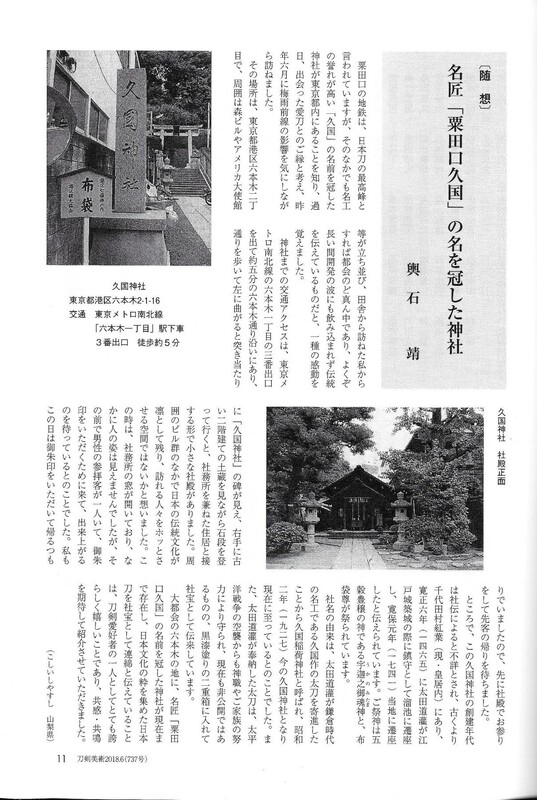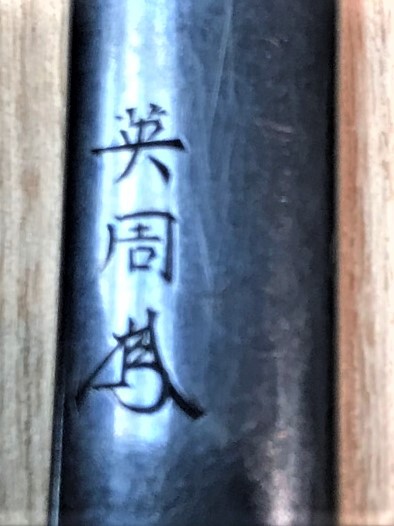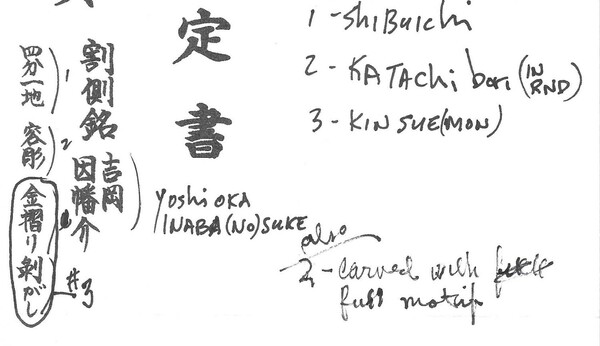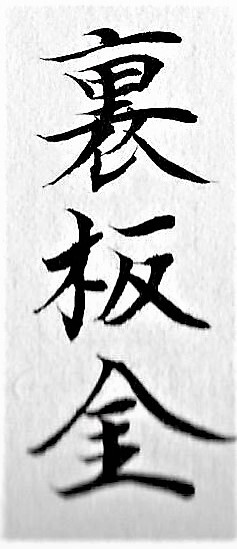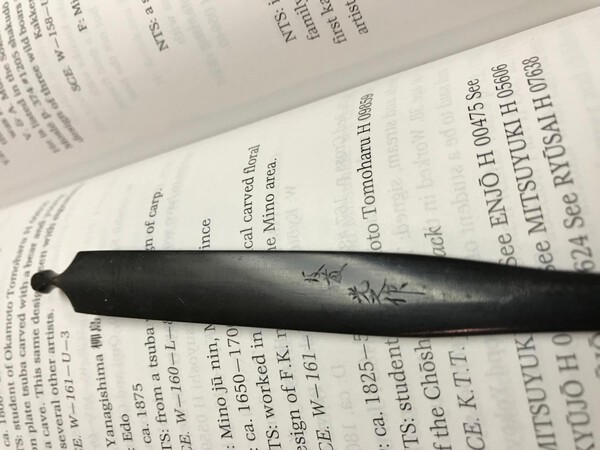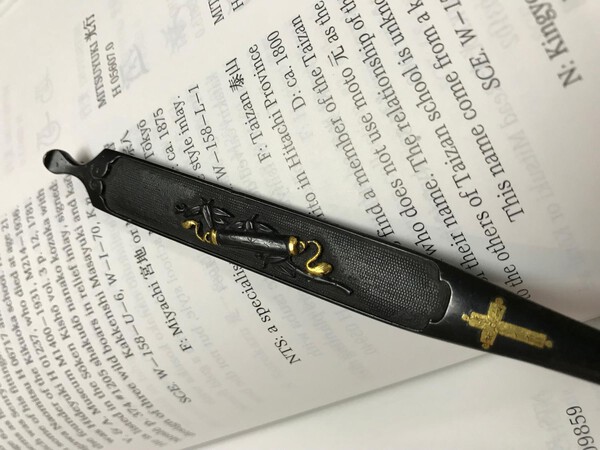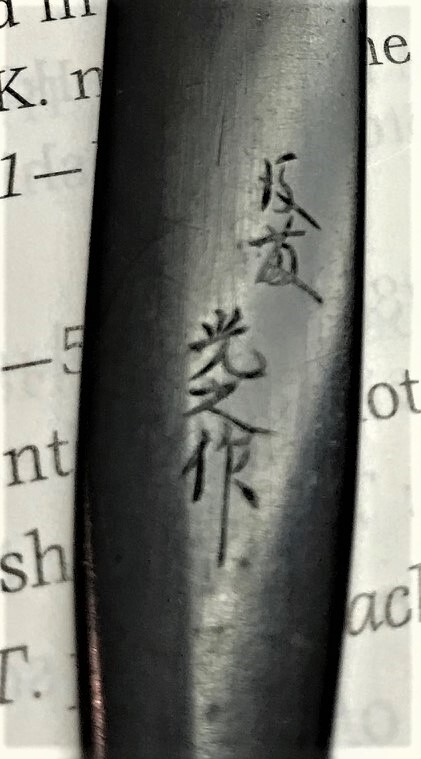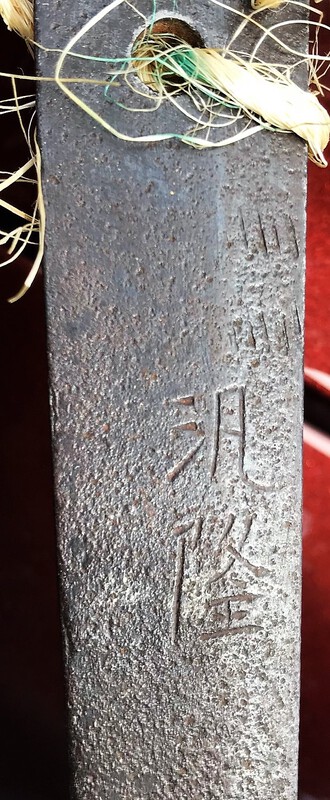-
Posts
703 -
Joined
-
Last visited
-
Days Won
4
Content Type
Profiles
Forums
Events
Store
Downloads
Gallery
Everything posted by Ron STL
-
Came across several banners/flags recently. I'd like to see what this smaller banner might be representing. Has the army star but can not put the two kanji together to make sense. Could it be something like "brothers" (brothers in arms?), but that doesn't sound very Japanese to me. Any answers here? Thanks in advance. Ron STL Banner.docx
-
One thing to check when the formal origami arrives, is the last column at far left. Sometimes the team will make a slight change to the dating of the item, swords in particular. I've also had the team change their call to "den" so-and-so to a specific smith, removing the general "den" once the team is back in Japan. Always good to check things over as best you can. Ron STL
-

Help On Showa Zodiac Dated Sword And Smith
Ron STL replied to Ron STL's topic in Translation Assistance
Thanks guys, for refreshing my memory. For some reason I seem to have a hang-up with recognizing the Mantetsu kanji, and have asked NMB this same question before. I was just looking at an Koa Isshin with the Mantetsu saku signature, but so it goes at times. Thanks Pete for mentioning the Shinshinto Taikan, I'd forgotten that handy list. Ron STL -
Just trying to figure out this smith and the date on this Showa era sword. I believe the date (zodiac form) looks like mizunoto hitsuji (1943) but what are the last one or two kanji? Also, the smith puzzles me, so a reading on this mei would also solve the puzzle. Always appreciated, guys and gals. Ron STL
-
-
Thanks Matt. Would be interesting to read but will most likely leave it alone. Always take note of Hisakuni material. Ron STL
-
2 - This sure looks like Jirotaro Naokatsu, if not the Naoaki. Surprised it's not signed. Ron STL
-
I noticed this article in June TB titled Awataguchi Hisakuni... Can somebody tell me what this article is about and what the picture captions are telling us? If interesting enough, I will ask Marcus for a translation. Thanks, Ron STL
-
I've emailed Bob McCoy and suggest he check in on this topic. Ron STL
-
Thanks Alex and everyone else who helped with confirming this mei and kao. I'm impressed. I also was at the Tanobe lecture in Tampa and came away with much more understanding on judging mei than I had before. I recall Mr. Tanobe's comments when confirming the mei on my Naotane, specifically referring to the "flow" of his mei and kakihan used at that specific date. I do find it more difficult to judge mei and kao on fittings, though. If the workman ship fits what would be expected for the carver, I'm hopeful, only to find the often very tiny signature, kao and sometimes seal that looks so good is bounced by the shinsa team. Even the late Edo carvers who signed "big names" on fitters did an amazing job using hammers and chisels. And yes, Tanobe san is indeed a great teacher, a sharing teacher to all of us. Ron STL
-
These will be one of the items illustrated and discussed in the 2019 KTK catalog. Thought they would look good in print plus be interesting to study. Ron STL
-
These miniatures can be very nice work. I believe Bob McCoy who handles the newsletter for the Norther California group collects or used to collect these. I'm pretty sure he wrote an article about them for their newsletter maybe eight or so years ago. Might be worthwhile to contact Bob about this topic for some answers. He might even be on NMB, I'm not sure. Ron STL
-
Glad you found this posting, Curran. I bought the Bauer book when it came out but soon traded it for a pair of textbook ko-Mino menuki from Keith Hostler, I think. (When we were much younger!) If the kao looks right in Bauer, that should be the same man Haynes indexed. Have a more clear photo attached here. Brian, I checked Markus' signature book but did not find anything there. As always, thanks for the help when help is needed. Ron STL
-
I'm trying to confirm that I've got the correct Teruchika (Haynes H 09555.0) of the Sonoba family, ca. 1800s work. If someone would have the Bauer Collection book, a mei is supposed to be on p.438 and maybe again on p.319 according to Haynes references. Hopefully his kao will match up with the one on this very beautiful kogai that I've owned for quite a few years. Always a story: the late Rad Smith bought this from an early fittings collector, Larry Vanice who had it papered in the 1970s. Rad later sold it to me. Makes me wonder how many collectors today remember these guys. It was fun collecting back then, for sure. Ron STL
-
Thanks Markus, I'm aware of what you described but do not recall ever hearing or reading the name of this "artificially worn" treatment before. So this is very helpful and I'll have to make note of it so as to recognize it the next time that technique comes along. Again, my thanks for explaining this to me. Ron STL
-
Need clarification on what is written about the gold technique used on these "frog" menuki. It is circled as #3 on my notes on the paper copy. Earlier, I was told it was kin sue (mon) but honestly, I can not find a clear definition of that. I'd like to have a full reading of this #3 term and just what it means. The applied gold finish "resembles" what one sees on Ezo menuki but of course it's not the same. Thanks Ron STL
-
Thanks guys. John's reading makes sense, considering this refers to a kogai. Peter, I actually managed to get a few things figured out yesterday using Nelson's, an accomplishment for this old midwesterner. A post of mine online about this kogai has been interesting. Motif is of a stingray's stinger (spine), apparently made into a spear. Taken from an Edo book of unusual tales, so it seems. Will post a photo here FYI. Kogai signed by Takahashi Masatsugu (kao). Meanwhile, thanks again for the translation. Ron STL
-
Apologies up front for asking help on this, but I've been unable to find what technique was used on a kogai. As long as I've been collecting I still have not found a good list of techniques used on fittings, a combo of both the kanji for the technique and its English name. Besides this translation...I'm curious what source for this information is recommended? Ron STL
-

Yari Signed Sukemune Nyudo Saku Ura Information Puzzle
Ron STL replied to Ron STL's topic in Translation Assistance
This is rather amazing to me. I don't ever recall reading anything on yari testing. I'm not surprised that this inscription puzzled me. Gruesome job, testing, but all part of the history of these interesting objects we collect and study. I believe my friend who sold this to me bought it off eBay, a Japanese seller, a year or so ago. I'll have to take some photos of the yari itself, interestingly with a pleasant hitatsura showing what appears to be utsuri. I thank all of you guys for coming up with this information for me and sharing it with others on NMB who might one day come across another such puzzle. Ron STL -
This is about a very strong yari signed Sukemune nyudo saku (mei not yet studied) which has what, to me, is a complicated inscription on the ura. I've worked on this at length but without enough success to understand it. Perhaps one of you fluent in Japanese can clarify it. I suspect it is dated Kei 3 (1850) and possibly relates to some shinshinto owner. It looks like perhaps (?) Chikuzen (variation) Katsu...hide? An interesting inscription that may be of interest to NMB followers other than myself. I've taken a number of photos but will post only a few that may be enough to understand what this is all about. Any and all comments will help to understand what was written here, centuries after Sukemitsu (hopefully) made this strong yari. Thanks all. Ron STL
-
Pete, I'll bring it to Chicago. I heard from Chris Leung who also mentioned waki Goto man. I saw several other names in Haynes that used Mitsuyuki but ran out of time to dig too deep. Leaving in A.M. for the windy city. Ron STL
-
This is an interesting shakudo kogai which has a well done hidden Christian cross on it. When inserted into the kogai pocket the cross is hidden. A friend bought this a few years ago and I finally talked him out of it. The maker is MITSUYUKI. What I can't read and need to understand are the first two kanji above the makers name. Haynes lists a half dozen MITSUYUKI on page 1124 in the middle volume of his Index, but none of these seem to show these first two kanji. I was hoping these read GOTO but no luck there. Anyone have an answer on this? Would appreciate that very much. Chicago show is upon us. I'll have a table as always. A few fittings for sale but only swords are for show & tell; Hatakeda Moriie and Hojoji Kunimitsu, both Juyo. Stop over and have a look. Ron STL
-
Hirotaka...how about that. I even came up with the name but couldn't convince myself I was correct. Thanks Ray. I had lunch with a fellow retiree today. He found this bare blade in a junk place, laying with some old tools and stuff. As bad as the surface condition is for the blade, there are no big chips or from what I could see, deep rust. He said to take it home but I was happy with the photo. Will study it more to see if there seems to be any hope in the mei being correct. If so, I'll see about rescuing it from total destruction. Ron STL
-
Guys and gals, this mei has defeated me although it looks simple enough. Who is this smith? Says Echizen ju on the other side of nakago. Blade is totally neglected. Thanks. Ron STL
-
Thanks guys, this is more info than was found before. Feathers are not a problem since the owner wanting this done lives in the country and finds (and keeps) lost hawk feathers for such a purpose. I'll pass this info on to him along with any more that comes in. Ron STL





